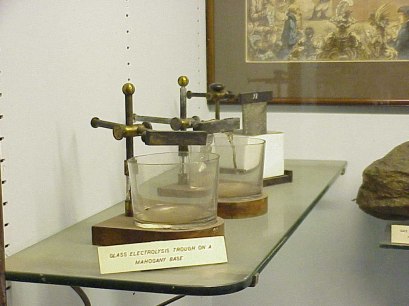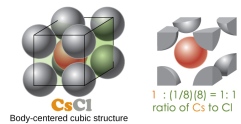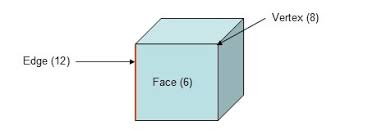If a biographer of Humphry Davy wanted to reinforce the scientist-stereotype, he would emphasize how a young Davy was turned on to chemistry by reading Lavoisier’s book and how he was discharged from an apothecary for causing explosive reactions. He would mention his bad habit of inhaling gases, which probably helped shorten his life to 51 years. Most importantly the biographer would highlight Davy’s discovery of seven chemical elements, more than anyone in history except for the discoverers of synthetic nuclear elements, which I find less exciting.

Davy’s early electrolysis equipment Credit: J & J Marshall http://www.chem.unt.edu/~jimm
And the details of Davy’s discoveries are indeed stimulating for aficionados of chemistry. He first attempted to obtain elements by decomposing saturated alkali solutions. It’s easy for us to understand why such an attempt was in vain. But the concept of ions was almost a century away, so he could not have possibly foreseen that water generates hydrogen ions, which attract electrons better than any alkali ion. Yet he was clever enough to then try it without water, to use the solid salts themselves, exposing them to air just enough to make their surface conduct. Instead of failing like others who had heated the solids as if they were akin to oxides of mercury, Davy applied a battery’s current to potash. And it worked! Even when he switched the wires around, he would always observe effervescence at the positive pole. and at the opposite pole, pearls of metal briefly appeared. Then some globules tarnished while others exploded in the air. If water was added to the metal, the result would be just as dramatic: he would get hydrogen gas, which in the presence of potassium, burnt with a lovely lavender light.
Of course there are other positive characteristics associated with the scientist-stereotype. The biographer would have to not only outline his discoveries but discuss how Davy considered the possibility that he was wrong, just in case his substances weren’t new elements. Indeed Davy did switch his platinum electrode with other materials to check if the material itself was involved in the reaction. But copper, gold, silver and lead alloys all yielded the same result. When others like Gay Lussac had suspected that the hydrogen was coming out of the potassium, so named because it came from potash, Davy revealed that in the absence of water, no gas could come out of potassium or sodium. He really had discovered new elements. Eight years later, in 1815, Davy saved lives by inventing a miner’s safety lamp. Its gauze’s holes let oxygen in, and when they were of the right size, the metal surface cooled and blocked the spread of the flame, preventing the ignition of explosive methane from deep coal mines.

On the left is Davy’s lamp. On the right is a an earlier prototype that did not work so well. From the Royal Institution’s archives. Photo by Paul Wilkinson.

Humphry Davy from Wikimedia Commons
So what should a biographer add about Davy, so as not to reinforce the common image the public has of scientists: Davy’s enthusiasm for fishing? A mention of his good looks, the reason that some ladies attended his public lectures? The most pronounced atypical characteristic about Davy is that he wrote poetry throughout his life. J. Z. Fullmer writes ,
In his science, he had searched into the hidden and mysterious ways of
nature. In his poetry he had truly worshiped and adored Nature’s
“majesty of visible creations.” He was Philosopher, Sage, and Poet.
In one of his notebooks Davy recorded the following. It’s not verse but certainly prose of a poetic nature:
To-day, for the first time in my life, I have had a distinct sympathy with
nature. I was lying on the top of a rock to leeward; the wind was high, and
everything was in motion; the branches of an oak tree were waving and murmuring to the breeze; yellow clouds, deepened by grey at the base, were rapidly floating over the western hills; the whole sky was in motion; the yellow stream
below was agitated by the breeze; everything was alive, and myself part of the
series of visible impression. I should have felt pain in tearing a leaf from one of
the trees. Memoirs Volume 1 p113
If such an experience is the exception, it begs the question, is such a perception of the world among scientists any more rare than it is in the rest of the population? Poetry aside, the thing that scientists have in common is an above average interest and devotion to science. But like any other group, there are more differences within their kind than there are between them and other people.
Sources:
The discovery of the elements. IX. Three alkali metals: Potassium, sodium, and lithium. Mary Elvira Weeks J. Chem. Educ., 1932, 9 (6), p 1035.
The Poetry of Sir Humphry Davy. J. Z. Fullmer. Chymia, Vol. 6 (1960), pp. 102-126
University of California Press. https://www.jstor.org/stable/27757194 :
Humphry Davy’s miners’ safety lamp
http://www.rigb.org/our-history/iconic-objects/iconic-objects-list/davy-lamp


















 Like society in general, science needs a variety of both skills and viewpoints to survive. Some of its devotees have been ingenious experimentalists; others have devised elegant theories solely from their desks. Some combine both skills and manage research teams. Many scientists, like natural philosophers of yesteryear, remain focused on providing humanity with insight into the universe. Others want to assist engineers and investors to derive more practical benefits. Since the pursuit of convenience is accompanied by costs to culture, health and the environment, we are also lucky to have scientists who focus on providing checks and balances.
Like society in general, science needs a variety of both skills and viewpoints to survive. Some of its devotees have been ingenious experimentalists; others have devised elegant theories solely from their desks. Some combine both skills and manage research teams. Many scientists, like natural philosophers of yesteryear, remain focused on providing humanity with insight into the universe. Others want to assist engineers and investors to derive more practical benefits. Since the pursuit of convenience is accompanied by costs to culture, health and the environment, we are also lucky to have scientists who focus on providing checks and balances. The more we crowd ourselves on the planet, the more likely we are to communicate diseases amongst ourselves, take ourselves for granted, and stress our planet for the resources we need to survive. Asimov, who was usually very optimistic, felt strongly about this serious problem which we have mostly ignored after a surge of interest in the 1960s and 1970s.
The more we crowd ourselves on the planet, the more likely we are to communicate diseases amongst ourselves, take ourselves for granted, and stress our planet for the resources we need to survive. Asimov, who was usually very optimistic, felt strongly about this serious problem which we have mostly ignored after a surge of interest in the 1960s and 1970s.